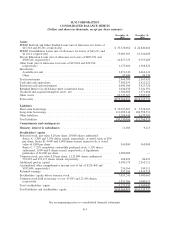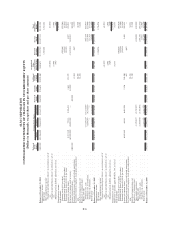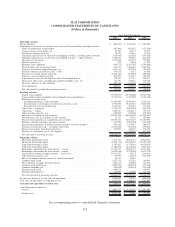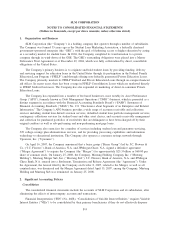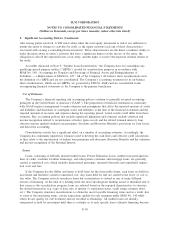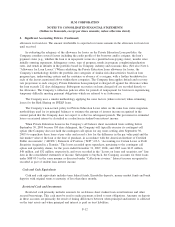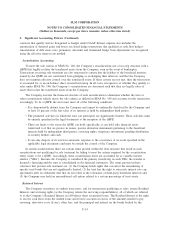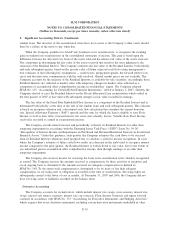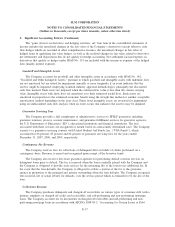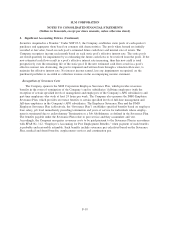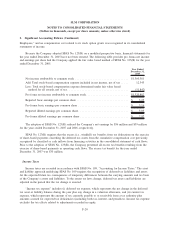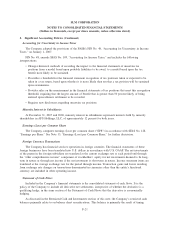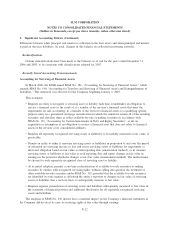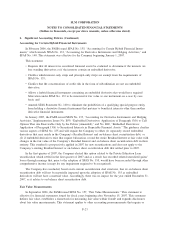Sallie Mae 2007 Annual Report Download - page 135
Download and view the complete annual report
Please find page 135 of the 2007 Sallie Mae annual report below. You can navigate through the pages in the report by either clicking on the pages listed below, or by using the keyword search tool below to find specific information within the annual report.2. Significant Accounting Policies (Continued)
contracts that qualify and are designated as hedges under GAAP. Interest expense also includes the
amortization of deferred gains and losses on closed hedge transactions that qualified as cash flow hedges.
Amortization of debt issue costs, premiums, discounts and terminated hedge basis adjustments are recognized
using the effective interest rate method.
Securitization Accounting
To meet the sale criteria of SFAS No. 140, the Company’s securitizations use a two-step structure with a
QSPE that legally isolates the transferred assets from the Company, even in the event of bankruptcy.
Transactions receiving sale treatment are also structured to ensure that the holders of the beneficial interests
issued by the QSPE are not constrained from pledging or exchanging their interests, and that the Company
does not maintain effective control over the transferred assets. If these criteria are not met, then the transaction
is accounted for as an on-balance sheet secured borrowing. In all cases, irrespective of whether they qualify as
sales under SFAS No. 140, the Company’s securitizations are structured such that they are legally sales of
assets that isolate the transferred assets from the Company.
The Company assesses the financial structure of each securitization to determine whether the trust or
other securitization vehicle meets the sale criteria as defined in SFAS No. 140 and accounts for the transaction
accordingly. To be a QSPE, the trust must meet all of the following conditions:
• It is demonstrably distinct from the Company and cannot be unilaterally dissolved by the Company and
at least 10 percent of the fair value of its interests is held by independent third parties.
• The permitted activities in which the trust can participate are significantly limited. These activities must
be entirely specified in the legal documents at the inception of the QSPE.
• There are limits to the assets the QSPE can hold; specifically, it can hold only financial assets
transferred to it that are passive in nature, passive derivative instruments pertaining to the beneficial
interests held by independent third parties, servicing rights, temporary investments pending distribution
to security holders and cash.
• It can only dispose of its assets in automatic response to the occurrence of an event specified in the
applicable legal documents and must be outside the control of the Company.
In certain securitizations there are certain terms present within the deal structure that result in such
securitizations not qualifying for sale treatment by failing to meet the criteria required for the securitization
entity (trust) to be a QSPE. Accordingly, these securitization trusts are accounted for as variable interest
entities (“VIEs”). Because the Company is considered the primary beneficiary in such VIEs, the transfer is
deemed a financing and the trust is consolidated in the financial statements. The terms present in these
structures that prevent sale treatment are: (1) the Company holds rights that can affect the remarketing of
specific trust bonds that are not significantly limited, (2) the trust has the right to enter into interest rate cap
agreements after its settlement date that do not relate to the reissuance of third-party beneficial interests and
(3) the Company may hold an unconditional call option related to a certain percentage of trust assets.
Retained Interest
The Company securitizes its student loan assets, and for transactions qualifying as sales, retains Residual
Interests and servicing rights (as the Company retains the servicing responsibilities), all of which are referred
to as the Company’s Retained Interest in off-balance sheet securitized loans. The Residual Interest is the right
to receive cash flows from the student loans and reserve accounts in excess of the amounts needed to pay
servicing, derivative costs (if any), other fees, and the principal and interest on the bonds backed by the
F-14
SLM CORPORATION
NOTES TO CONSOLIDATED FINANCIAL STATEMENTS
(Dollars in thousands, except per share amounts, unless otherwise stated)


